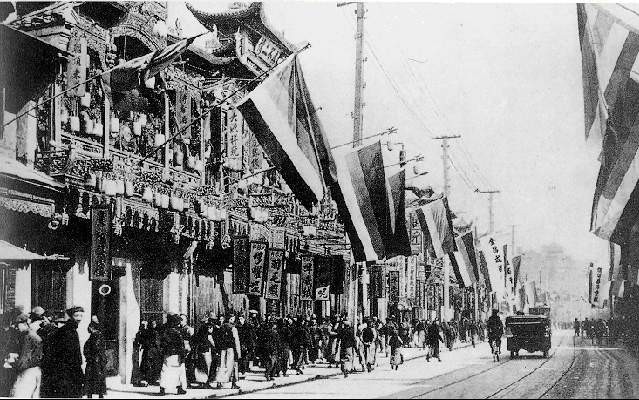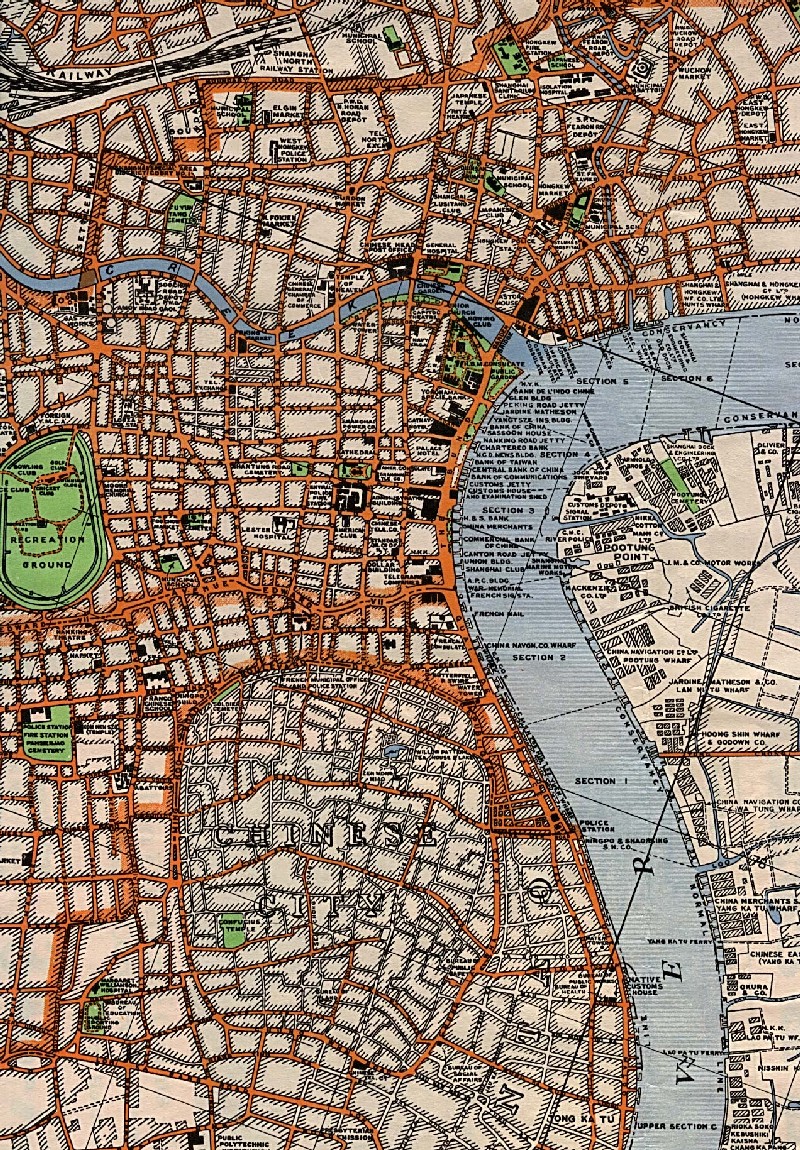|
Nanjing Road (Shanghai)
Nanjing Road (; Shanghainese: ''Noecin Lu'') is a road in Shanghai, the eastern part of which is the main shopping district of Shanghai. It is one of the world's busiest shopping streets, along with Fifth Avenue, Oxford Street, Orchard Road, Takeshita Street and the Champs-Élysées. The street is named after the city of Nanjing, capital of Jiangsu province neighbouring Shanghai, and the former national capital of the Republic of China. Today's Nanjing Road comprises two sections, Nanjing Road East and Nanjing Road West. In some contexts, "Nanjing Road" refers only to what was pre-1945 Nanjing Road, today's Nanjing Road East, which is largely pedestrianised. Before the adoption of the pinyin romanisation in the 1950s, its name was rendered as Nanking Road in English. The former Nanking Road lay entirely within the Shanghai International Settlement. Today's Nanjing Road West was formerly Bubbling Well Road, an extra-settlement road built by concession authorities outside the con ... [...More Info...] [...Related Items...] OR: [Wikipedia] [Google] [Baidu] |
Shanghainese
The Shanghainese language, also known as the Shanghai dialect, or Hu language, is a variety of Wu Chinese spoken in the central districts of the City of Shanghai and its surrounding areas. It is classified as part of the Sino-Tibetan language family. Shanghainese, like the rest of the Wu language group, is mutually unintelligible with other varieties of Chinese, such as Mandarin. Shanghainese belongs a separate group of the Taihu Wu subgroup. With nearly 14 million speakers, Shanghainese is also the largest single form of Wu Chinese. Since the late 19th century it has served as the lingua franca of the entire Yangtze River Delta region, but in recent decades its status has declined relative to Mandarin, which most Shanghainese speakers can also speak. Like other Wu varieties, Shanghainese is rich in vowels and consonants, with around twenty unique vowel qualities, twelve of which are phonemic. Similarly, Shanghainese also has voiced obstruent initials, which is rare ... [...More Info...] [...Related Items...] OR: [Wikipedia] [Google] [Baidu] |
The Bund
The Bund or Waitan (, Shanghainese romanization: ''Nga3thae1'', , ) is a waterfront area and a protected historical district in central Shanghai. The area centers on a section of Zhongshan Road (East Zhongshan Road No.1) within the former Shanghai International Settlement, which runs along the western bank of the Huangpu River in the eastern part of Huangpu District. The area along the river faces the modern skyscrapers of Lujiazui in the Pudong District. The Bund usually refers to the buildings and wharves on this section of the road, as well as some adjacent areas. From the 1860s to the 1930s, it was the rich and powerful center of the foreign establishment in Shanghai, operating as a legally protected treaty port. Name The term "bund" was borrowed into English from Hindustani and originally referred to a dyke or embankment. Within the Chinese treaty ports, it was applied specifically to an embanked quay which ran along the shore. The Chinese name for the Bund is unrelate ... [...More Info...] [...Related Items...] OR: [Wikipedia] [Google] [Baidu] |
Peace Hotel
The Peace Hotel () is a hotel on The Bund in Shanghai, China, which overlooks the surrounding areas. The hotel has two different buildings. The Sassoon House, originally housed the Cathay Hotel and is today the Fairmont Peace Hotel run by Fairmont Hotels and Resorts of Canada. The South Building was built as the Palace Hotel and is today a residence and studio for artists, known as The Swatch Art Peace Hotel. The two buildings both face the Bund, but are divided by Nanjing Road. North Building The larger North Building is called Sassoon House. The building was built by Sir Victor Sassoon, of the Sassoon family, which built a Shanghai business and real estate empire in the early 20th century. He was a British Sephardic Jew of Iraqi origin, educated at Harrow School and Cambridge University. His family owned the trading company " E.D. Sassoon & Co.", which managed extensive business interests in Bombay, Hong Kong, and Shanghai. Sassoon House was the first high-rise building bu ... [...More Info...] [...Related Items...] OR: [Wikipedia] [Google] [Baidu] |
The Bund
The Bund or Waitan (, Shanghainese romanization: ''Nga3thae1'', , ) is a waterfront area and a protected historical district in central Shanghai. The area centers on a section of Zhongshan Road (East Zhongshan Road No.1) within the former Shanghai International Settlement, which runs along the western bank of the Huangpu River in the eastern part of Huangpu District. The area along the river faces the modern skyscrapers of Lujiazui in the Pudong District. The Bund usually refers to the buildings and wharves on this section of the road, as well as some adjacent areas. From the 1860s to the 1930s, it was the rich and powerful center of the foreign establishment in Shanghai, operating as a legally protected treaty port. Name The term "bund" was borrowed into English from Hindustani and originally referred to a dyke or embankment. Within the Chinese treaty ports, it was applied specifically to an embanked quay which ran along the shore. The Chinese name for the Bund is unrelate ... [...More Info...] [...Related Items...] OR: [Wikipedia] [Google] [Baidu] |
Pedestrian Street
Pedestrian zones (also known as auto-free zones and car-free zones, as pedestrian precincts in British English, and as pedestrian malls in the United States and Australia) are areas of a city or town reserved for pedestrian-only use and in which most or all automobile traffic is prohibited. Converting a street or an area to pedestrian-only use is called ''pedestrianisation''. Pedestrianisation usually aims to provide better accessibility and mobility for pedestrians, to enhance the amount of shopping and other business activities in the area or to improve the attractiveness of the local environment in terms of aesthetics, air pollution, noise and crashes involving motor vehicle with pedestrians. However, pedestrianisation can sometimes lead to reductions in business activity, property devaluation, and displacement of economic activity to other areas. In some cases, traffic in surrounding areas may increase, due to displacement, rather than substitution of car traffic. None ... [...More Info...] [...Related Items...] OR: [Wikipedia] [Google] [Baidu] |
Japanese Cruiser Izumo
was the lead ship of her class of armored cruisers (''Sōkō jun'yōkan'') built for the Imperial Japanese Navy (IJN) in the late 1890s. As Japan lacked the industrial capacity to build such warships itself, the ship was built in Britain. She often served as a flagship and participated in most of the naval battles of the Russo-Japanese War of 1904–1905. The ship was lightly damaged during the Battle off Ulsan and the Battle of Tsushima. ''Izumo'' was ordered to protect Japanese citizens and interests in 1913 during the Mexican Revolution and was still there when World War I began in 1914. She was then tasked to search for German commerce raiders and protect Allied shipping off the western coasts of North and Central America. The ship assisted the armored cruiser in early 1915 when she struck a rock off Baja California. In 1917, ''Izumo'' became the flagship of the Japanese squadron deployed in the Mediterranean Sea. After the war, she sailed to Great Britain to take contr ... [...More Info...] [...Related Items...] OR: [Wikipedia] [Google] [Baidu] |
World War II
World War II or the Second World War, often abbreviated as WWII or WW2, was a world war that lasted from 1939 to 1945. It involved the vast majority of the world's countries—including all of the great powers—forming two opposing military alliances: the Allies and the Axis powers. World War II was a total war that directly involved more than 100 million personnel from more than 30 countries. The major participants in the war threw their entire economic, industrial, and scientific capabilities behind the war effort, blurring the distinction between civilian and military resources. Aircraft played a major role in the conflict, enabling the strategic bombing of population centres and deploying the only two nuclear weapons ever used in war. World War II was by far the deadliest conflict in human history; it resulted in 70 to 85 million fatalities, mostly among civilians. Tens of millions died due to genocides (including the Holocaust), starvation, massa ... [...More Info...] [...Related Items...] OR: [Wikipedia] [Google] [Baidu] |
Xizang Road
The Tibet Autonomous Region or Xizang Autonomous Region, often shortened to Tibet or Xizang, is a province-level autonomous region of the People's Republic of China in Southwest China. It was overlayed on the traditional Tibetan regions of Ü-Tsang and Kham. It was formally established in 1965 to replace the Tibet Area, the former administrative division of the People's Republic of China (PRC) established after the annexation of Tibet. The establishment was about five years after the 1959 Tibetan uprising and the dismissal of the Kashag, and about 13 years after the original annexation. The current borders of the Tibet Autonomous Region were generally established in the 18th century and include about half of historic Tibet, or the ethno-cultural Tibet. The Tibet Autonomous Region spans over and is the second-largest province-level division of China by area, after Xinjiang. Due to its harsh and rugged terrain, it is sparsely populated at just over 3.6 million people with ... [...More Info...] [...Related Items...] OR: [Wikipedia] [Google] [Baidu] |
Shanghai Sincere Building
Shanghai (; , , Standard Mandarin pronunciation: ) is one of the four direct-administered municipalities of the People's Republic of China (PRC). The city is located on the southern estuary of the Yangtze River, with the Huangpu River flowing through it. With a population of 24.89 million as of 2021, Shanghai is the most populous urban area in China with 39,300,000 inhabitants living in the Shanghai metropolitan area, the second most populous city proper in the world (after Chongqing) and the only city in East Asia with a GDP greater than its corresponding capital. Shanghai ranks second among the administrative divisions of Mainland China in human development index (after Beijing). As of 2018, the Greater Shanghai metropolitan area was estimated to produce a gross metropolitan product ( nominal) of nearly 9.1 trillion RMB ($1.33 trillion), exceeding that of Mexico with GDP of $1.22 trillion, the 15th largest in the world. Shanghai is one of the world's major centers for f ... [...More Info...] [...Related Items...] OR: [Wikipedia] [Google] [Baidu] |






